|
01. R. L3-240 |
3370 |
|
|
R-M |
|
104 - Unknown |
I |
|
|
Jaeger, J.J. 1976. Les rongeurs (Mammalia, Rodentia) du Pleistocene inferieur d’Olduvai Bed I (Tanzanie) 1ere Partie: Les Murides. Fossil vertebrates of Africa 4:58-120. |
This species is found at FLK NNI layer 2 and 3; FLK NI layers 1-6; FLK I Main site. It is unclear where individual specimens were recovered. |
|
|
|
Unknown |
|
Mammalia |
Rodentia |
Myomorpha |
Myodonta |
Muroidea |
Muridae |
Murinae |
|
Zelotomys |
leakeyi |
|
|
No |
|
01. R. M2-272 |
3402 |
|
|
R-MAX-f, M |
|
104 - Unknown |
I |
|
|
Jaeger, J.J. 1976. Les rongeurs (Mammalia, Rodentia) du Pleistocene inferieur d’Olduvai Bed I (Tanzanie) 1ere Partie: Les Murides. Fossil vertebrates of Africa 4:58-120. |
This species is found at FLK NNI layer 2 and 3; FLK NI layers 1-6; FLK I Main site. It is unclear where individual specimens were recovered. |
|
|
|
Unknown |
|
Mammalia |
Rodentia |
Myomorpha |
Myodonta |
Muroidea |
Muridae |
Murinae |
|
Zelotomys |
leakeyi |
|
|
No |
|
01. R. L3-272 |
3404 |
|
|
R-MAX-f, M |
|
104 - Unknown |
I |
|
|
Jaeger, J.J. 1976. Les rongeurs (Mammalia, Rodentia) du Pleistocene inferieur d’Olduvai Bed I (Tanzanie) 1ere Partie: Les Murides. Fossil vertebrates of Africa 4:58-120. |
This species is found at FLK NNI layer 2 and 3; FLK NI layers 1-6; FLK I Main site. It is unclear where individual specimens were recovered. |
|
|
|
Unknown |
|
|
|
|
|
|
|
|
|
|
|
|
|
No |
|
OVPP-Elephantulus 7 |
2853 |
7 - FLK North |
|
MAX-f, P |
|
122 - National Museum and House of Culture, Dar es Salaam, Tanzania |
I |
|
3 |
Butler, P., and Greenwood, M. 1976. Elephant-shrews (Macroscelididae) from Olduvai and Makapansgat. In: Fossil Vertebrates of Africa,vol. 4. pp. 1-56. |
|
|
|
264 - Leakey family expedition |
Yes |
|
Mammalia |
Insectivora |
|
|
|
Macroscelididae |
|
|
Elephantulus |
fuscus |
leakeyi |
|
No |
|
OVPP-Elephantulus 54 |
2900 |
7 - FLK North |
|
M |
|
122 - National Museum and House of Culture, Dar es Salaam, Tanzania |
I |
|
4 |
Butler, P., and Greenwood, M. 1976. Elephant-shrews (Macroscelididae) from Olduvai and Makapansgat. In: Fossil Vertebrates of Africa,vol. 4. pp. 1-56. |
|
|
|
264 - Leakey family expedition |
Unknown |
|
Mammalia |
Insectivora |
|
|
|
Macroscelididae |
|
|
Elephantulus |
antiquus |
|
|
No |
|
S. 61 |
3120 |
23 - TK |
|
CRA-f, MAN-f |
1961 |
104 - Unknown |
II |
|
|
Leakey, M., and Leakey, R. 1976. Further Cercopithecinae (Mammalia, Primates) from the Plio/Pleistocene of East Africa. Fossil vertebrates of Africa 4:121-146. |
This specimen is crushed. |
|
|
264 - Leakey family expedition |
Yes |
|
Mammalia |
Primates |
Anthropoidea |
Haplorhini |
Cercopithecoidea |
Cercopithecidae |
Cercopithecinae |
Papionini |
Papio |
sp. |
|
|
No |
|
M. 22407 |
1571 |
19 - SHK |
|
HUM-f |
|
106 - Natural History Museum UK (?) |
II |
|
|
Gentry, A. W. 1966 Fossil Antilopini of East Africa. Bulletin of the British Museum of Natural History, Geology. 12: 43-106. 9 pls. |
There are two juvenile humerus specimens with the number M. 22407. |
|
|
273 - Reck expedition |
Unknown |
|
Mammalia |
Artiodactyla |
Ruminantia |
|
Bovoidea |
Bovidae |
Antilopinae |
Neotragini |
Phenacotragus |
recki |
|
|
No |
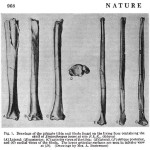 |
OH 6 |
3721 |
5 - FLK |
283 - 45 |
CRA-f
, M-f
, L-P
, L-TIB-f
, L-FIB-f
, |
1959/60 |
122 - National Museum and House of Culture, Dar es Salaam, Tanzania |
I |
Middle (Zinj.) |
Surface. Cranial and dental fragments found in surface soil from slope immediately below Zinj. site; assumed to be from Zinj. level (Leakey, MD, 1971:227). TIB-f and FIB-f from Zinj. level. |
Davis, P. R. 1964. Hominid fossils from Bed I, Olduvai Gorge, Tanganyika. A tibia and fibula. Nature. 201, 967. |
From Tobias (1991): OH 35 tibia and fibula attributed to same individual as OH 6 but appear to be more mature. It is unclear if OH 35 tibia and fibula are the same tibia and fibula originally listed under OH 6. Leakey, MD, 1971 describes CRA and dental fragments as having been found in surface soil, but Leakey, Tobias, and Napier, 1964 state "some [were] found in situ [and] some on the surface" (:9). Unworn lower L-P3. Partially developed roots of upper M1 or 2. Six cranial vault fragments. Tibia and fibula fragments first assumed to be associated with Zinjanthropus OH5, but should be considered associates with OH 6 following morphological study (Leakey, MD, 1971:227). and skull fragments. Juvenile. Specimen previously housed at National Museum of Kenya. |
|
|
264 - Leakey family expedition |
Unknown |
|
Mammalia |
Primates |
Anthropoidea |
Haplorhini |
Hominoidea |
Hominidae |
Homininae |
Hominini |
Homo |
habilis |
|
Paratype. TIB-f and FIB-f not given taxonomic designation in original publication (Davis, 1964) but named as a paratype in Leakey, Tobias, and Napier, 1964. |
No |
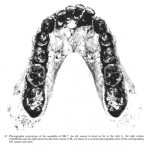 |
OH 7 |
3722 |
6 - FLK NN |
283 - 45 |
MAN
, L-PAR
, R-PAR-f
, M
, OCC-f
, L/R-TEM-f
, PHX
, CAR |
1960 |
122 - National Museum and House of Culture, Dar es Salaam, Tanzania |
I |
3 |
On surface of clay immediately overlying Tuff IB. |
Leakey, L.S.B., Tobias, P.V. & Napier, J.R. 1964. A new species of the genus Homo from Olduvai Gorge. Nature 202(4927): 7-9. |
Holotype. "Jonny's Child". Juvenile. Mandible with partial dentition and unerupted R/L-M3, almost complete left parietal and fragments of right parietal, left and right petrous portions (temporal) , "sundry small skull fragments ... [and] twenty-one bones of the hand, including the trapezium, scaphoid and a number of phalanges" (Leakey, MD, 1971:228). "One upper molar, a terminal phalanx, and a broken capitate bone, found on the surface, probably also belong to this individual" (:226). Specimen previously housed at National Museum of Kenya. |
|
|
264 - Leakey family expedition |
Yes |
|
Mammalia |
Primates |
Anthropoidea |
Haplorhini |
Hominoidea |
Hominidae |
Homininae |
Hominini |
Homo |
habilis |
|
Holotype |
No |
|
OH 12 |
3727 |
18 - VEK |
286 - 86 |
OCC
, L/R-PAR
, L/R-TEM-f
, CRA-f
, L-PAL
, L-MAX
, TOOTH-f |
1962 |
122 - National Museum and House of Culture, Dar es Salaam, Tanzania |
IV? |
a |
Surface. Found on eroded slope of Bed III. L-TEM-f from just below marker Tuff IVa. |
Leakey, L., and Leakey, M. 1964. Recent discoveries of fossil hominids in tanganyika: at Olduvai and near Lake Natron. Nature 202:5-7. |
Crowns of teeth not preserved. Bed IVA determined on basis of matrix adhering to L-TEM-f and PAL. Specimen previously housed at National Museum of Kenya. |
|
|
264 - Leakey family expedition |
No |
L-TEM-f & PAL found with matrix adhering. |
Mammalia |
Primates |
Anthropoidea |
Haplorhini |
Hominoidea |
Hominidae |
Homininae |
Hominini |
Homo |
erectus |
|
|
No |
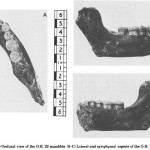 |
OH 22 |
3737 |
73 - VEK/MNK |
|
R-MAN-f
, R-P
, R-M
, R-I-f
, R-C-f |
1968 |
122 - National Museum and House of Culture, Dar es Salaam, Tanzania |
III/IV |
|
Surface, indeterminate gravel |
Leakey MD. (1971) Olduvai Gorge, Vol. 3: excavations in Beds I & II 1960-1963. New York, NY: Cambridge University Press. |
Right half of mandible with roots of I1-C and complete P3-M2. Specimen previously housed at National Museum of Kenya. |
|
|
264 - Leakey family expedition |
No |
|
Mammalia |
Primates |
Anthropoidea |
Haplorhini |
Hominoidea |
Hominidae |
Homininae |
Hominini |
Homo |
cf. erectus |
|
|
No |
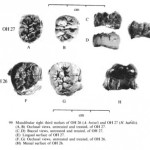 |
OH 27 |
3742 |
37 - HWK EE |
|
R-M |
1969 |
122 - National Museum and House of Culture, Dar es Salaam, Tanzania |
I |
3 meters below Tuff IF |
Surface. |
Tobias, PV. 1991. The Skulls, endocasts and teeth of Homo habilis. Cambridge: University Press. |
Lower M3, unworn. "It is not possible to indicate more than broadly the original position of this tooth, since the clays above and below Tuff IF, as well as the Sandy Conglomerate, are all fossiliferous in this areaand yield mammalian teeth in a similar state of preservation to the hominid molar...the tooth was derived from either Upper Bed I or Lower Bed II" (Tobias, 1991:849). Specimen previously housed at National Museum of Kenya. |
|
|
264 - Leakey family expedition |
No |
|
Mammalia |
Primates |
Anthropoidea |
Haplorhini |
Hominoidea |
Hominidae |
Homininae |
Hominini |
Homo |
habilis |
|
|
No |
|
OH 28 |
3743 |
38 - WK |
290 - 36 |
L-PVG-f
, L-FEM-f |
1970 |
122 - National Museum and House of Culture, Dar es Salaam, Tanzania |
IV |
a |
|
Leakey MD. (1971) Olduvai Gorge, Vol. 3: excavations in Beds I & II 1960-1963. New York, NY: Cambridge University Press. |
Left femoral shaft and left innominate. Specimen previously housed at National Museum of Kenya. |
|
|
264 - Leakey family expedition |
Yes |
|
Mammalia |
Primates |
Anthropoidea |
Haplorhini |
Hominoidea |
Hominidae |
Homininae |
Hominini |
Homo |
erectus |
|
|
No |
|
OH 29 |
3744 |
76 - JK W |
|
M-f |
1969 |
122 - National Museum and House of Culture, Dar es Salaam, Tanzania |
III/IVa |
|
|
Leakey MD. (1971) Olduvai Gorge, Vol. 3: excavations in Beds I & II 1960-1963. New York, NY: Cambridge University Press. |
Specimen previously housed at National Museum of Kenya. |
|
|
264 - Leakey family expedition |
Yes |
|
Mammalia |
Primates |
Anthropoidea |
Haplorhini |
Hominoidea |
Hominidae |
|
|
|
|
|
|
No |
|
OH 31 |
3746 |
14 - HWK E |
|
M-f |
1969 |
122 - National Museum and House of Culture, Dar es Salaam, Tanzania |
I |
Upper |
Surface 1.5 m below Tuff IF |
Tobias, PV. 1991. The Skulls, endocasts and teeth of Homo habilis. Cambridge: University Press. |
Specimen previously housed at National Museum of Kenya. |
|
|
264 - Leakey family expedition |
No |
|
Mammalia |
Primates |
Anthropoidea |
Haplorhini |
Hominoidea |
Hominidae |
Homininae |
Hominini |
Homo |
|
|
|
No |
|
OH 32 |
3747 |
27 - MNK |
|
M-f |
1969 |
122 - National Museum and House of Culture, Dar es Salaam, Tanzania |
II |
Middle |
Surface. |
|
Broken. Specimen previously housed at National Museum of Kenya. |
|
|
264 - Leakey family expedition |
No |
|
Mammalia |
Primates |
Anthropoidea |
Haplorhini |
Hominoidea |
Hominidae |
Homininae |
Hominini |
Homo |
|
|
|
No |
|
OH 34 |
3749 |
76 - JK W |
|
FEM
, TIB-f |
1962 |
122 - National Museum and House of Culture, Dar es Salaam, Tanzania |
III/ IV |
for Bed IV level = a |
|
Leakey MD. (1971) Olduvai Gorge, Vol. 3: excavations in Beds I & II 1960-1963. New York, NY: Cambridge University Press. |
Femur described as "slender" (Leakey MD, 1971) and shaft of tibia. Specimen previously housed at National Museum of Kenya. |
|
|
264 - Leakey family expedition |
Yes |
|
Mammalia |
Primates |
Anthropoidea |
Haplorhini |
Hominoidea |
Hominidae |
Homininae |
Hominini |
Homo |
sp. |
|
Slender bone |
No |
|
OH 51 |
3766 |
35 - GTC |
|
L-MAND-f, L-P, L-M |
1974 |
122 - National Museum and House of Culture, Dar es Salaam, Tanzania |
III |
|
Surface. |
-- |
Mandible fragment with P4 and M1. Specimen previously housed at National Museum of Kenya. |
|
|
264 - Leakey family expedition |
No |
|
Mammalia |
Primates |
Anthropoidea |
Haplorhini |
Hominoidea |
Hominidae |
Homininae |
Hominini |
Homo |
erectus |
|
|
No |
|
OH 53 |
3768 |
19 - SHK |
|
R-FEM |
1957 |
122 - National Museum and House of Culture, Dar es Salaam, Tanzania |
II |
Middle |
|
-- |
Specimen previously housed at National Museum of Kenya. |
|
|
264 - Leakey family expedition |
Yes |
|
Mammalia |
Primates |
Anthropoidea |
Haplorhini |
Hominoidea |
Hominidae |
Homininae |
Hominini |
Homo |
|
|
|
No |
|
OH 54 |
3769 |
72 - FLK Maiko Gully |
|
M-f |
1969 |
122 - National Museum and House of Culture, Dar es Salaam, Tanzania |
I |
|
Surface. |
-- |
Half of lower M1 or M2. Specimen previously housed at National Museum of Kenya. |
|
|
264 - Leakey family expedition |
No |
|
Mammalia |
Primates |
Anthropoidea |
Haplorhini |
Hominoidea |
Hominidae |
|
|
|
|
|
|
No |
|
OH 55 |
3770 |
78 - FLK S |
|
M-f |
1976 |
122 - National Museum and House of Culture, Dar es Salaam, Tanzania |
I |
|
Surface. |
-- |
Weathered crown of molar. Specimen previously housed at National Museum of Kenya. |
|
|
264 - Leakey family expedition |
No |
|
Mammalia |
Primates |
Anthropoidea |
Haplorhini |
Hominoidea |
Hominidae |
Homininae |
Hominini |
Homo |
habilis |
|
|
No |
|
OH 60 |
3775 |
5 - FLK |
|
M |
1982 |
122 - National Museum and House of Culture, Dar es Salaam, Tanzania |
I |
|
Surface. |
-- |
Large M3. Specimen previously housed at National Museum of Kenya. |
|
|
264 - Leakey family expedition |
No |
|
Mammalia |
Primates |
Anthropoidea |
Haplorhini |
Hominoidea |
Hominidae |
|
|
Australopithecus |
boisei |
|
|
No |
|
OH 63 |
3778 |
6 - FLK NN |
|
M |
1988 |
122 - National Museum and House of Culture, Dar es Salaam, Tanzania |
I |
|
|
|
"Found near the OH 7 site" -R. Clarke 2011.�Specimen is a lower molar. Specimen previously housed at National Museum of Kenya. |
|
|
264 - Leakey family expedition |
Unknown |
|
Mammalia |
Primates |
Anthropoidea |
Haplorhini |
Hominoidea |
Hominidae |
|
|
Australopithecus |
|
|
|
No |
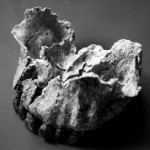 |
OH 65 |
3780 |
|
82 - 64 |
MAX
, TOOTH |
1995 |
127 - National Natural History Museum, Arusha, Tanzania |
I |
Middle/Upper |
|
Blumenschine, R. J., Peters, C. R., Masao, F. T., et al. 2003. Late Pliocene Homo and Hominid Land Use from Western Olduvai Gorge, Tanzania. Science 299, 1217-1221. |
Author describes specimen as "complete maxilla with all teeth and lower face of adult".�Specimen is pictured in images 1-11. (Images from R. Clarke 2011). |
|
|
|
Yes |
|
Mammalia |
Primates |
Anthropoidea |
Haplorhini |
Hominoidea |
Hominidae |
Homininae |
Hominini |
Homo |
habilis |
|
Large habilis |
No |
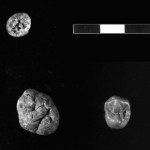 |
OH 67 |
3782 |
14 - HWK E |
|
M-f |
2001 |
127 - National Natural History Museum, Arusha, Tanzania |
II |
Lowermost |
Surface. |
|
Upper adult fragment. Specimen is pictured on top right in image 1. |
|
|
|
No |
|
Mammalia |
Primates |
Anthropoidea |
Haplorhini |
Hominoidea |
Hominidae |
|
|
|
|
|
Homo or Australopithecus |
No |
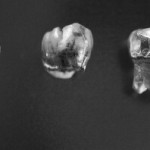 |
OH 68 |
3783 |
18 - VEK |
|
Mand-f, R-P-f |
2001 |
127 - National Natural History Museum, Arusha, Tanzania |
II |
Lower |
|
|
Mandible fragment with unerupted P4 and root of M1.�Specimen is pictured in the middle in image 1.�Specimen is shown in the middle of the top row in image 2. |
|
|
|
Yes |
|
Mammalia |
Primates |
Anthropoidea |
Haplorhini |
Hominoidea |
Hominidae |
|
|
Australopithecus |
africanus |
|
OH 13-like |
No |
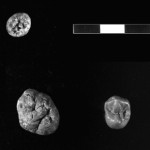 |
OH 70 |
3785 |
80 - MCK |
|
L-M-f |
2002 |
127 - National Natural History Museum, Arusha, Tanzania |
II |
Lower |
|
|
Distrobuccal portion of upper M1 crown.�Specimen is pictured on bottom right of image 1. |
|
|
|
Yes |
|
Mammalia |
Primates |
Anthropoidea |
Haplorhini |
Hominoidea |
Hominidae |
|
|
Australopithecus |
africanus |
|
OH 24-like |
No |
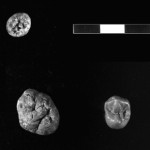 |
OH 74 |
3789 |
72 - FLK Maiko Gully |
|
L-M |
2007 |
127 - National Natural History Museum, Arusha, Tanzania |
I |
ID above |
Surface. |
|
Left M2, unerupted.�Specimen is pictured second from the bottom left in image 1.�Specimen is shown on right in image 2. |
|
|
|
No |
|
Mammalia |
Primates |
Anthropoidea |
Haplorhini |
Hominoidea |
Hominidae |
|
|
Australopithecus� |
boisei |
|
|
No |
|
OH 75 |
3790 |
5 - FLK |
|
R-HUM |
2009 |
127 - National Natural History Museum, Arusha, Tanzania |
I |
Zinjanthropus |
Surface. |
OLAPP/Earthwatch”Discovered by an Earthwatch project led by F.T. Masao in 2003 and 2004, respectively, and will be described elsewhere.” -R. Clarke (2011) |
|
|
|
|
No |
|
Mammalia |
Primates |
Anthropoidea |
Haplorhini |
Hominoidea |
hominidae |
|
|
|
|
|
A. cf. africanus/H. habilis�OH 62-like |
No |
|
OH 76 |
3791 |
55 - FLK W |
|
R-M |
2010 |
127 - National Natural History Museum, Arusha, Tanzania |
II |
Upper? |
Surface. |
“Discovered by an Earthwatch project led by F.T. Masao in 2003 and 2004, respectively, and will be described elsewhere.” -R. Clarke (2011) |
Right upper M1 with roots. |
|
|
|
No |
|
Mammalia |
Primates |
Anthropoidea |
Haplorhini |
Hominoidea |
Hominidae |
|
|
|
|
|
|
No |
|
OH 77 |
3792 |
14 - HWK E |
|
L-M-f |
2010 |
127 - National Natural History Museum, Arusha, Tanzania |
II |
Lowermost |
Surface. |
OLAPP/Earthwatch”Discovered by an Earthwatch project led by F.T. Masao in 2003 and 2004, respectively, and will be described elsewhere.” -R. Clarke (2011) |
Left upper M2 crown. |
|
|
|
No |
|
Mammalia |
Primates |
Anthropoidea |
Haplorhini |
Hominoidea |
Hominidae |
|
|
Australopithecus |
africanus |
|
|
No |
|
OH 80 |
3796 |
10 - BK |
|
R/L-P
, L-M
, R/L-I
, L-HUM-f
, R-RAD-f
, R-FEM-f
, TIB-f |
2009 |
122 - National Museum and House of Culture, Dar es Salaam, Tanzania |
II |
4 |
Upper |
Domínguez-Rodrigo M, et al. 2013. First Partial Skeleton of a 1.34-Million-Year-Old Paranthropus boisei from Bed II, Olduvai Gorge, Tanzania. PLoS ONE 8(12): e80347. |
Distal portion of a left humerus diaphysis. Partial right radius with head, proximal metaphysis and partial diaphysis. Right partial femur, diaphysis in three refitting pieces. Tibia midshaft fragment assigned to OH 80 based on close "spatial association, comparable anatomical ruggedness and similar state of preservation to the other OH 80 postcranial fossils" (Dominiguez-Rodrigo et al., 2013). |
|
|
292 - Proyecto Olduvai |
Yes |
|
Mammalia |
Primates |
Anthropoidea |
Haplorhini |
Hominoidea |
Hominidae |
Homininae |
Hominini |
Australopithecus |
boisei |
|
Anatomically modern |
No |
|
OVPP-Mammalia |
3801 |
83 - FLK NW |
|
AST, (n=33), CAL, (n=73), FEM, (n=272), HUM, (n=186), I, (n=316), M, (n=108), MAN, (n=161), MAX, (n=68), MTP, (n=257), PHX, (n=77), PVG, (n=218), RAD, (n=55), SCP, (n=40), TIB, (n=395), ULNA, (n=76), VER, (n=595) |
|
|
I |
20 |
|
Arcos, S., Sevilla, P., and Fernandez-Jalvo, Y. 2010. Preliminary small mammal taphonomy of FLK NW level 20 (Olduvai Gorge, Tanzania). Quarternary Research 74:405-410. |
MNI is 198. Authors describe specimens as "small mammals". |
|
|
|
Unknown |
|
Mammalia |
|
|
|
|
|
|
|
|
� |
|
Authors describe specimens as "small mammals". |
No |
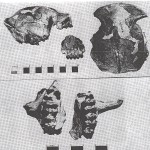 |
MLK 068/6514 |
3803 |
34 - MLK |
|
CRA-f, P, M, (n=3) |
|
|
II |
Lower |
From horizon above Lemuta Member of Lowed Bed II |
Leakey MG and Leakey REF. 1973. New large Pleistocene colobinae (Mammalia, Primates) from East Africa. Fossil Vertebrates of Africa Vol. 3, 121-38. |
Similar to colobine specimen KNM-ER 398 in cranial dimensions. �Maxillary dentition represented by P4, M2, M1, M2. �Crania is represented by multiple fragments, and some fragments are missing. �Large canine socket of right maxilla indicates specimen is male. �Specimen is pictured in Plate 3. � |
|
|
264 - Leakey family expedition |
Unknown |
|
Mammalia |
Primates |
Anthropoidea |
Haplorhini |
Cercopithecoidea |
Cercopithecidae |
|
|
|
|
|
Either Cercopithecinae or Cynopithencinae. Author states that the cranium is typical of Cercopithecinae but that the dental morphology resembles Cynopithecinae. |
No |
|
OVPP-Otomys 4 |
3858 |
6 - FLK NN |
|
CRA-f, M, (n=3) |
|
|
I |
3 |
|
Denys, C. 1989. Phylogenetic affinities of the oldest East African Otomys (Rodentia, Mammalia) from Olduvai Bed I (Pleistocene, Tanzania). Neues Jahrbuch f |
Cranium has left and right upper M123.� |
|
|
|
Unknown |
|
Mammalia |
Rodentia |
Myomorpha |
Myodonta |
Muroidea |
Muridae |
Murinae |
Otomyini |
Otomys |
petteri |
|
|
No |
|
OVPP-Otomys 5 |
3859 |
5 - FLK |
|
MAN-f, (n=41), M, (n=143) |
|
|
I |
|
|
Denys, C. 1989. Phylogenetic affinities of the oldest East African Otomys (Rodentia, Mammalia) from Olduvai Bed I (Pleistocene, Tanzania). Neues Jahrbuch f |
Mandible fragments have M1-M3.�Author states that specimens come from FLKI, FLKNNI layers K, L2, L3, FLKNI layers M1-M6 but does not specify which specimen came from where.�Paper is a systematical study and does not provide specific details about each specimen. |
|
|
|
Unknown |
|
Mammalia |
Rodentia |
Myomorpha |
Myodonta |
Muroidea |
Muridae |
Murinae |
Otomyini |
Otomys |
petteri |
|
|
No |
|
OVPP-Otomys 6 |
3860 |
5 - FLK |
|
MAN-f, (n=78), M, (n=156) |
|
|
I |
|
|
Denys, C. 1989. Phylogenetic affinities of the oldest East African Otomys (Rodentia, Mammalia) from Olduvai Bed I (Pleistocene, Tanzania). Neues Jahrbuch f |
Mandible fragments have M1 and M2.�Author states that specimens come from FLKI, FLKNNI layers K, L2, L3, FLKNI layers M1-M6 but does not specify which specimen came from where.�Paper is a systematical study and does not provide specific details about each specimen. |
|
|
|
Unknown |
|
Mammalia |
Rodentia |
Myomorpha |
Myodonta |
Muroidea |
Muridae |
Murinae |
Otomyini |
Otomys |
petteri |
|
|
No |
|
OVPP-Otomys 7 |
3861 |
5 - FLK |
|
MAN-f, (n=4), M, (n=8) |
|
|
I |
|
|
Denys, C. 1989. Phylogenetic affinities of the oldest East African Otomys (Rodentia, Mammalia) from Olduvai Bed I (Pleistocene, Tanzania). Neues Jahrbuch f |
Mandible fragments have M2 and M3.�Author states that specimens come from FLKI, FLKNNI layers K, L2, L3, FLKNI layers M1-M6 but does not specify which specimen came from where.�Paper is a systematical study and does not provide specific details about each specimen. |
|
|
|
Unknown |
|
Mammalia |
Rodentia |
Myomorpha |
Myodonta |
Muroidea |
Muridae |
Murinae |
Otomyini |
Otomys |
petteri |
|
|
No |
|
OVPP-Otomys 8 |
3862 |
5 - FLK |
|
MAN-f, (n=61), M, (n=61) |
|
|
I |
|
|
Denys, C. 1989. Phylogenetic affinities of the oldest East African Otomys (Rodentia, Mammalia) from Olduvai Bed I (Pleistocene, Tanzania). Neues Jahrbuch f |
Mandible fragments have M1.�Author states that specimens come from FLKI, FLKNNI layers K, L2, L3, FLKNI layers M1-M6 but does not specify which specimen came from where.�Paper is a systematical study and does not provide specific details about each specimen. |
|
|
|
Unknown |
|
Mammalia |
Rodentia |
Myomorpha |
Myodonta |
Muroidea |
Muridae |
Murinae |
Otomyini |
Otomys |
petteri |
|
|
No |
|
OVPP-Otomys 9 |
3863 |
5 - FLK |
|
MAN-f, M |
|
|
I |
|
|
Denys, C. 1989. Phylogenetic affinities of the oldest East African Otomys (Rodentia, Mammalia) from Olduvai Bed I (Pleistocene, Tanzania). Neues Jahrbuch f |
Mandible fragment has M2.�Author states that specimens come from FLKI, FLKNNI layers K, L2, L3, FLKNI layers M1-M6 but does not specify which specimen came from where. |
|
|
|
Unknown |
|
Mammalia |
Rodentia |
Myomorpha |
Myodonta |
Muroidea |
Muridae |
Murinae |
Otomyini |
Otomys |
petteri |
|
|
No |









